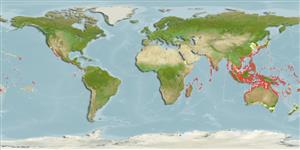Common names from other countries
Classification / Names / Names
Nomi Comuni | Sinonimi | Catalog of Fishes (gen., sp.) | ITIS | CoL | WoRMS
Environment: milieu / climate zone / depth range / distribution range
Ecologia
Associati a barriera corallina; distribuzione batimetrica 19 - 42 m (Ref. 83472). Tropical
Indo-West Pacific: Kenya to Japan, Caroline and Marshall Islands.
Length at first maturity / Size / Peso / Age
Maturity: Lm ? range ? - ? cm
Epizoic, subtidal (Ref. 106854). Inhabits muddy sand and rubble (Ref. 77944) and is associated with the gorgonian, Junceella sp. (Ref. 83471).
Life cycle and mating behavior
Maturità | Riproduzione | Deposizione | Uova | Fecundity | Larve
Members of the order Decapoda are mostly gonochoric. Mating behavior: Precopulatory courtship ritual is common (through olfactory and tactile cues); usually indirect sperm transfer.
Li, X., A.J. Bruce and R.B. Manning. 2004. (Ref. 77944)
IUCN Red List Status (Ref. 130435)
CITES status (Ref. 108899)
Not Evaluated
Not Evaluated
Human uses
| FishSource |
Strumenti
Informazioni ulteriori
Age/Size
Accrescimento
Length-weight
Length-length
Morfologia
Larve
Abbondanza
Fonti Internet
Estimates based on models
Preferred temperature
(Ref.
115969): 22.8 - 28.7, mean 27.7 (based on 284 cells).
